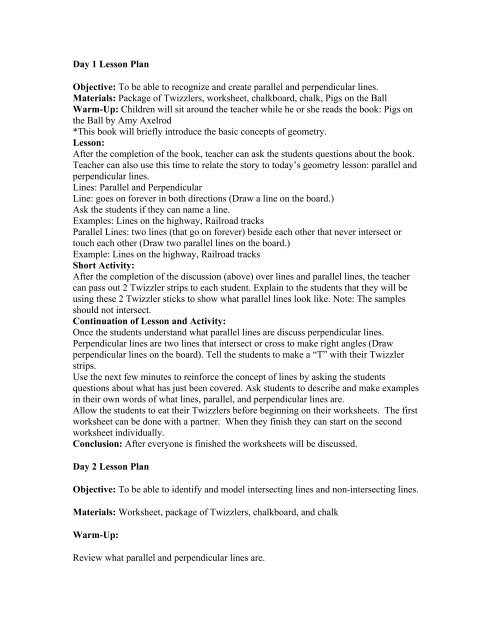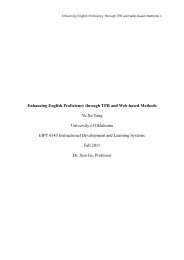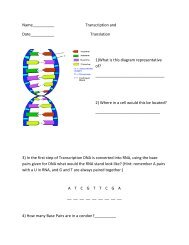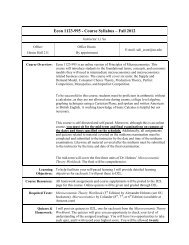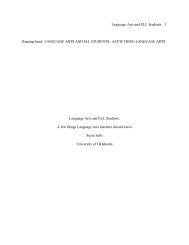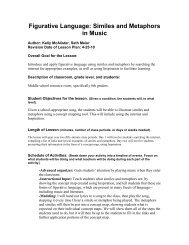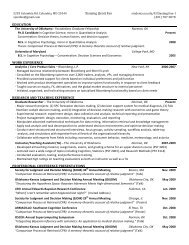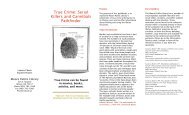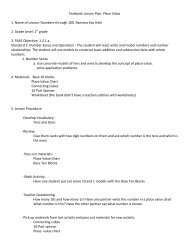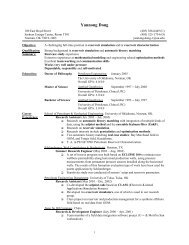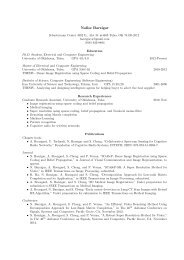Day 1 Lesson Plan Objective: To be able to ... - Students.ou.edu
Day 1 Lesson Plan Objective: To be able to ... - Students.ou.edu
Day 1 Lesson Plan Objective: To be able to ... - Students.ou.edu
- No tags were found...
You also want an ePaper? Increase the reach of your titles
YUMPU automatically turns print PDFs into web optimized ePapers that Google loves.
<strong>Day</strong> 1 <strong>Lesson</strong> <strong>Plan</strong><strong>Objective</strong>: <strong>To</strong> <strong>be</strong> <strong>able</strong> <strong>to</strong> recognize and create parallel and perpendicular lines.Materials: Package of Twizzlers, worksheet, chalkboard, chalk, Pigs on the BallWarm-Up: Children will sit ar<strong>ou</strong>nd the teacher while he or she reads the book: Pigs onthe Ball by Amy Axelrod*This book will briefly introduce the basic concepts of geometry.<strong>Lesson</strong>:After the completion of the book, teacher can ask the students questions ab<strong>ou</strong>t the book.Teacher can also use this time <strong>to</strong> relate the s<strong>to</strong>ry <strong>to</strong> <strong>to</strong>day’s geometry lesson: parallel andperpendicular lines.Lines: Parallel and PerpendicularLine: goes on forever in both directions (Draw a line on the board.)Ask the students if they can name a line.Examples: Lines on the highway, Railroad tracksParallel Lines: two lines (that go on forever) <strong>be</strong>side each other that never intersect or<strong>to</strong>uch each other (Draw two parallel lines on the board.)Example: Lines on the highway, Railroad tracksShort Activity:After the completion of the discussion (above) over lines and parallel lines, the teachercan pass <strong>ou</strong>t 2 Twizzler strips <strong>to</strong> each student. Explain <strong>to</strong> the students that they will <strong>be</strong>using these 2 Twizzler sticks <strong>to</strong> show what parallel lines look like. Note: The samplessh<strong>ou</strong>ld not intersect.Continuation of <strong>Lesson</strong> and Activity:Once the students understand what parallel lines are discuss perpendicular lines.Perpendicular lines are two lines that intersect or cross <strong>to</strong> make right angles (Drawperpendicular lines on the board). Tell the students <strong>to</strong> make a “T” with their Twizzlerstrips.Use the next few minutes <strong>to</strong> reinforce the concept of lines by asking the studentsquestions ab<strong>ou</strong>t what has just <strong>be</strong>en covered. Ask students <strong>to</strong> descri<strong>be</strong> and make examplesin their own words of what lines, parallel, and perpendicular lines are.Allow the students <strong>to</strong> eat their Twizzlers <strong>be</strong>fore <strong>be</strong>ginning on their worksheets. The firstworksheet can <strong>be</strong> done with a partner. When they finish they can start on the secondworksheet individually.Conclusion: After everyone is finished the worksheets will <strong>be</strong> discussed.<strong>Day</strong> 2 <strong>Lesson</strong> <strong>Plan</strong><strong>Objective</strong>: <strong>To</strong> <strong>be</strong> <strong>able</strong> <strong>to</strong> identify and model intersecting lines and non-intersecting lines.Materials: Worksheet, package of Twizzlers, chalkboard, and chalkWarm-Up:Review what parallel and perpendicular lines are.
<strong>Lesson</strong>:Intersecting lines are two lines that cross and do not make a corner. (Draw intersectinglines on the board.)Non-intersecting lines look like this (Draw non-intersecting lines on the board). They aretwo lines that are not parallel, perpendicular, or intersecting.Have the children show the teacher what they look like with their arms. Ask the studentsab<strong>ou</strong>t what letters and num<strong>be</strong>rs contain intersecting lines.Activity:After everyone knows what intersecting and non-intersecting lines are, give everyone twoTwizzlers.Have the children make intersecting and non-intersecting lines with their Twizzlers.The students are then allowed <strong>to</strong> eat their Twizzlers while they complete a worksheetindividually.Conclusion: Review the worksheet with the students.<strong>Day</strong> 3 <strong>Lesson</strong> <strong>Plan</strong><strong>Objective</strong>: <strong>To</strong> <strong>be</strong> <strong>able</strong> <strong>to</strong> classify and draw different types of angles.Materials: Pipe cleaners, chalkboard, chalk, worksheet, and Pigs on the BallWarm-Up:Have the students sit ar<strong>ou</strong>nd the teacher while he or she asks the students questions ab<strong>ou</strong>trays and angles from the book. Question the students <strong>to</strong> see if anyone knows orremem<strong>be</strong>rs what rays and angles are.<strong>Lesson</strong>:Ray: has one endpoint and goes on foreverTeacher then can draw a ray on the board.Ask the students <strong>to</strong> compare a line and a ray.What is the difference?Angle: is the joining of two angles <strong>to</strong>gether at the vertex (corner)(Teacher can draw an angle on the board.)Ask the students if they can look and find anything ar<strong>ou</strong>nd the room that is an angle. Ifthe students do not find anything, the teacher can find many examples in the classroom.Ask the students how a ray and an angle are similar?How are they different?Explain <strong>to</strong> the students that there are many types of angles. However, <strong>to</strong>day we are onlygoing <strong>to</strong> learn ab<strong>ou</strong>t acute, right, and obtuse angles.Acute: angle that measures less than 90 degreesRight: angle that measures exactly 90 degreesObtuse: angle that measures more than 90 degreesActivity:
Activity and Conclusion: Do a worksheet <strong>to</strong>gether as a class.<strong>Day</strong> 5 <strong>Lesson</strong> <strong>Plan</strong><strong>Objective</strong>: <strong>To</strong> clarify everything the students have already learned.Materials: Worksheet, chalkboard, chalk, prizeWarm-Up: Ask the students if anyone has any questions ab<strong>ou</strong>t what has <strong>be</strong>en learnedduring the week. If there are any discrepancies among the students than review themisunders<strong>to</strong>od items.Activity:Do a review worksheet individually.After the worksheet has <strong>be</strong>en completed ask the students if they have any questions.Review Game:1. Divide the class in<strong>to</strong> two teams and have them sit with their team on either side of theroom.2. Have the students sit in the order in which they w<strong>ou</strong>ld like <strong>to</strong> go <strong>to</strong> the board.3. Explain <strong>to</strong> the students that one person from each team will go <strong>to</strong> the board. After theteacher has said the question the students may write the answer on the board. The firs<strong>to</strong>ne <strong>to</strong> finish writing the answer wins a point for their team. If there is a tie the teacherwill ask another question. (The teacher can keep score on a piece of paper.)4. The teacher can ask questions from any of the worksheets. (Assess the students ontheir understanding of the concepts thr<strong>ou</strong>gh<strong>ou</strong>t the game.)Conclusion: Ann<strong>ou</strong>nce the winner of the game and give them a prize.


